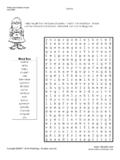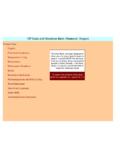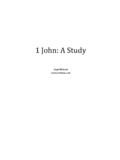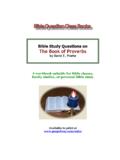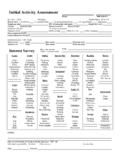Transcription of A POET IS LIMITED words sound
1 1 poetic DevicesPoetry is the kind of thing poets write. Robert FrostMan, if you gotta ask, you ll never know. Louis ArmstrongA POET IS LIMITED in the materials he can use in creating his works: all he has are words to expresshis ideas and feelings. These words need to be precisely right on several levels at once: they must sound right to the listener even as they delight his ear they must have a meaning which might have been unanticipated, but seems to bethe perfectly right one they must be arranged in a relationship and placed on the page in ways that areat once easy to follow and assist the reader in understanding they must probe the depths of human thought, emotion, and empathy, whileappearing simple, self-contained, and unpretentiousFortunately, the English language contains a wide range of words from which to choose for almostevery thought.
2 And there are also numerous plans or methods of arrangement of these words , calledpoetic devices , which can assist the writer in developing cogent expressions pleasing to his though most poetry today is read silently, it must still carry with it the feeling of being spokenaloud, and the reader should practice hearing it in order to catch all of the artfulness with whichthe poet has created his SOUNDS of wordsWords or portions of words can be clustered or juxtaposed to achieve specific kinds of effects when we hearthem. The sounds that result can strike us as clever and pleasing, even soothing. Others we dislike and striveto avoid.
3 These various deliberate arrangements of words have been : Repeated consonant sounds at the beginning of words placed near each other, usually on thesame or adjacent lines. A somewhat looser definition is that it is the use of the same consonant in anypart of adjacent : fast and furiousExample: Peter and Andrew patted the pony at AscotIn the second definition, both P and T in the example are reckoned as alliteration. It is noted that this isa very obvious device and needs to be handled with great restraint, except in specialty forms such aslimerick, cinquain, and humorous : Repeated vowel sounds in words placed near each other, usually on the same or adjacent should be in sounds that are accented, or stressed, rather than in vowel sounds that are : He s a bruisin loserIn the second example above, the short A sound in Andrew, patted, and Ascot would be : Repeated consonant sounds at the ending of words placed near each other, usually on thesame or adjacent lines.
4 These should be in sounds that are accented, or stressed, rather than in vowel 2 sounds that are unaccented. This produces a pleasing kind of : boats into the pastExample: cool soulCacophony A discordant series of harsh, unpleasant sounds helps to convey disorder. This is often furtheredby the combined effect of the meaning and the difficulty of : My stick fingers click with a snickerAnd, chuckling, they knuckle the keys;Light-footed, my steel feelers flickerAnd pluck from these keys melodies. Player Piano, John UpdikeEuphony: A series of musically pleasant sounds, conveying a sense of harmony and beauty to the : Than Oars divide the Ocean,Too silver for a seam Or Butterflies, off Banks of NoonLeap, plashless as they swim.
5 A Bird Came Down the Walk, Emily Dickenson (last stanza)Onomatopoeia: words that sound like their meanings. In Hear the steady tick of the old hall clock, theword tick sounds like the action of the clock, If assonance or alliteration can be onomatopoeic, as thesound ck is repeated in tick and clock, so much the better. At least sounds should suit the tone heavysounds for weightiness, light for the delicate. Tick is a light word, but transpose the light T to itsheavier counterpart, D; and transpose the light CK to its heavier counterpart G, and tick becomes themuch more solid and down to earth : boom, buzz, crackle, gurgle, hiss, pop, sizzle, snap, swoosh, whir, zipRepetition: The purposeful re-use of words and phrases for an effect.
6 Sometimes, especially with longerphrases that contain a different key word each time, this is called parallelism. It has been a central partof poetry in many cultures. Many of the Psalms use this device as one of their unifying : I was glad; so very, very : Half a league, half a league,Half a league to right of them,Cannon to left of them,Cannon in front of themVolley d and thunder : This is the one device most commonly associated with poetry by the general public. words thathave different beginning sounds but whose endings sound alike, including the final vowel sound andeverything following it, are said to : time, slime, mimeDouble rhymes include the final two syllables.
7 Example: revival, arrival, survivalTriple rhymes include the final three syllables. Example: greenery, machinery, sceneryA variation which has been used effectively is called slant rhyme, or half rhyme. If only the finalconsonant sounds of the words are the same, but the initial consonants and the vowel sounds aredifferent, then the rhyme is called a slant rhyme or half rhyme. When this appears in the middle of linesrather than at the end, it is called : soul, oil, foul; taut, sat, knitAnother variation which is occasionally used is called near rhyme. If the final vowel sounds are the 3 same, but the final consonant sounds are slightly different, then the rhyme is called a near : fine, rhyme; poem, goin Less effective but sometimes used are sight rhymes.
8 words which are spelled the same (as if theyrhymed), but are pronounced differently are called sight rhymes or eye : enough, cough, through, boughRhythm: Although the general public is seldom directly conscious of it, nearly everyone responds on somelevel to the organization of speech rhythms (verbal stresses) into a regular pattern of accented syllablesseparated by unaccented syllables. Rhythm helps to distinguish poetry from : i THOUGHT i SAW a patterns are sometimes referred to as meter. Meter is the organization of voice patterns, in termsof both the arrangement of stresses and their frequency of repetition per line of is organized by the division of each line into feet, metric units which each consist of a particu-lar arrangement of strong and weak stresses.
9 The most common metric unit is the iambic, in which anunstressed syllable is followed by a stressed one (as in the words reverse and compose).Scansion is the conscious measure of the pattern of stressed and unstressed syllables in a line ofpoetry. Stressed syllables are labeled with an accent mark: / Unstressed syllables are labeled with a dash: Metrical feet may be two or three syllables in length, and are divided by slashes: | There are five basic rhythms:PatternNameExample /Iamb/Iambicinvite/ Trochee/Trochaic deadline /Anapest/Anapestic to the beach/ Dactyl/Dactylicfrequently/ /Spondee/Spondaic true blueMeter is measured by the number of feet in a line.
10 Feet are named by Greek prefix number wordsattached to meter. A line with five feet is called pentameter; thus, a line of five iambs is known as iambic pentameter (the most common metrical form in English poetry , and the one favored byShakespeare).The most common line lengths are:monometer: one foottetrameter: four feetheptameter: seven feetdimeter: two feetpentameter: five feetoctameter: eight feettrimeter: three feethexameter: six feetNaturally, there is a degree of variation from line to line, as a rigid adherence to the meter results inunnatural or monotonous language. A skillful poet manipulates breaks in the prevailing rhythm of apoem for particular MEANINGs of wordsMost words convey several meanings or shades of meaning at the same time.
